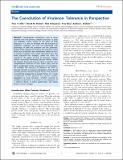Files in this item
The coevolution of virulence : tolerance in perspective
Item metadata
| dc.contributor.author | Little, Tom J. | |
| dc.contributor.author | Shuker, David M. | |
| dc.contributor.author | Colegrave, Nick | |
| dc.contributor.author | Day, Troy | |
| dc.contributor.author | Graham, Andrea L. | |
| dc.date.accessioned | 2013-12-03T09:31:06Z | |
| dc.date.available | 2013-12-03T09:31:06Z | |
| dc.date.issued | 2010-09 | |
| dc.identifier | 5103602 | |
| dc.identifier | 3ba31697-729c-44f9-80da-29061703f097 | |
| dc.identifier | 000282373000004 | |
| dc.identifier | 78149349843 | |
| dc.identifier.citation | Little , T J , Shuker , D M , Colegrave , N , Day , T & Graham , A L 2010 , ' The coevolution of virulence : tolerance in perspective ' , PLoS Pathogens , vol. 6 , no. 9 , e1001006 . https://doi.org/10.1371/journal.ppat.1001006 | en |
| dc.identifier.issn | 1553-7374 | |
| dc.identifier.uri | https://hdl.handle.net/10023/4237 | |
| dc.description.abstract | Coevolutionary interactions, such as those between host and parasite, predator and prey, or plant and pollinator, evolve subject to the genes of both interactors. It is clear, for example, that the evolution of pollination strategies can only be understood with knowledge of both the pollinator and the pollinated. Studies of the evolution of virulence, the reduction in host fitness due to infection, have nonetheless tended to focus on parasite evolution. Host-centric approaches have also been proposed-for example, under the rubric of "tolerance", the ability of hosts to minimize virulence without necessarily minimizing parasite density. Within the tolerance framework, however, there is room for more comprehensive measures of host fitness traits, and for fuller consideration of the consequences of coevolution. For example, the evolution of tolerance can result in changed selection on parasite populations, which should provoke parasite evolution despite the fact that tolerance is not directly antagonistic to parasite fitness. As a result, consideration of the potential for parasite counter-adaptation to host tolerance-whether evolved or medially manipulated-is essential to the emergence of a cohesive theory of biotic partnerships and robust disease control strategies. | |
| dc.format.extent | 5 | |
| dc.format.extent | 150312 | |
| dc.language.iso | eng | |
| dc.relation.ispartof | PLoS Pathogens | en |
| dc.subject | HOST-PARASITE INTERACTIONS | en |
| dc.subject | GENETIC-VARIATION | en |
| dc.subject | EVOLUTION | en |
| dc.subject | RESISTANCE | en |
| dc.subject | SELECTION | en |
| dc.subject | HYPOTHESIS | en |
| dc.subject | IMMUNOLOGY | en |
| dc.subject | DYNAMICS | en |
| dc.title | The coevolution of virulence : tolerance in perspective | en |
| dc.type | Journal item | en |
| dc.contributor.sponsor | NERC | en |
| dc.contributor.institution | University of St Andrews. School of Biology | en |
| dc.contributor.institution | University of St Andrews. Scottish Oceans Institute | en |
| dc.contributor.institution | University of St Andrews. Institute of Behavioural and Neural Sciences | en |
| dc.identifier.doi | https://doi.org/10.1371/journal.ppat.1001006 | |
| dc.description.status | Peer reviewed | en |
| dc.identifier.grantnumber | NE/D009979/2 | en |
This item appears in the following Collection(s)
Items in the St Andrews Research Repository are protected by copyright, with all rights reserved, unless otherwise indicated.

